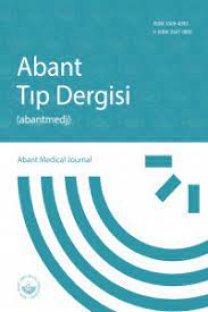Paranazal Sinüs Anatomik Varyasyonlu Hastalarda Alerjik Rinit Sıklığı
Alerjik rinit, kronik rinosinüzit, paranasal sinüsler, bilgisayarlı tomografi, alerjenler, deri testleri.
The Prevalence of Allergic Rhinitis in Patients with Anatomic Variations of Paranasal Sinus
Allergic rhinitis, chronic rhinosinusitis, paranasal sinuses, computed tomography, allergens, skin tests.,
___
- Saravelos SH, Cocksedge KA, Tin-Chiu L. Prevalence and diagnosis of congenital uterine anomalies in women with reproductive failure: a critical appraisal. Human Reproduction Update 2008; 14: 415-29.
- Li S, Qayyum A, Coakley FV, Hricak H. Association of renal agenesis and mullerian duct anomalies. Journal of computer assisted tomography 2000; 24: 829-34.
- Heinonen PK. Complete septate uterus with longitudinal vaginal septum. Fertility and sterility 2006; 85: 700-5.
- Perez-Brayfield MR, Clarke HS, Pattaras JG. Complete bladder, urethral, and vaginal duplication in a 50-year-old woman. Urology 2002; 60: 514.
- Holschneider A, Hutson J, Pena A, et al. Preliminary report on the interınational conference for the developıment of standards for the treatment of anorectal malformations. J Pediatr Surg 2005; 40: 1521-6.
- Moazam F, Talbert JL. Congenital anorectal malformations. Arch Surg 1985;120: 858-9.
- Nievelstein RA, Vos A, Valk J. MR imaging of anorectal malformations and associated anomalies. Eur Radiol 1998; 8(4): 573-81.
- Shaul DB, Harrison EA. Classification of anorectal malformations-initial approach, diagnostic tests and colostomy. Semin Pediatr Surg 1997; 6: 187-95.
- Yayın Aralığı: Yılda 6 Sayı
- Başlangıç: 2012
- Yayıncı: Bolu Abant İzzet Baysal Üniversitesi Tıp Fakültesi Dekanlığı
Gebelikte Görülen Nadir Bir Akut Karın Nedeni: İncebarsak İskemisi
Bayram ÇOLAK, Serdar YORMAZ, Ilhan ECE, Ertuğrul KAFALI, Fahrettin ACAR, Mustafa ŞAHİN
Kawasaki Hastalığında Güncel Gelişmeler
Hayrettin Hakan AYKAN, Süheyla ÖZKUTLU
Tümörden Tümöre Metastaz: Warthin Tümöründe Kutanöz Yassı Hücreli Karsinom
Çetin BORAN, Asuman KİLİTCİ, Hilal AHSEN
Çocukluk Çağı Delici Göz Yaralanmaları: Sebepler ve Sonuçlar
Ultrason Eşliğinde Santral Venöz Kateterizasyon Esnasında Fark Edilen Yaygın Trombüs: Bir Olgu
Hamit YOLDAŞ, İbrahim KARAGÖZ, Muhammed Emin DEMİRKOL, Yusuf VELİOĞLU, İsa YILDIZ
A Case Report: Dual Innervation Of The Brachioradialis Muscle
Wagner Evre III ve IV Diyabetik Ayak Ülserlerinin Mikrobiyolojik Değerlendirmesi
Fatih TEKİN, Mehmet SÜRMELİ, Ergin IŞIK, Furkan Erol KARABEKMEZ
Paranazal Sinüs Anatomik Varyasyonlu Hastalarda Alerjik Rinit Sıklığı
Erkan SOYLU, Alper YENİGÜN, Ömer Faruk ÇALIM, Ahmet Mahmut TEKİN, Fahrettin YILMAZ, İlknur Haberal CAN
